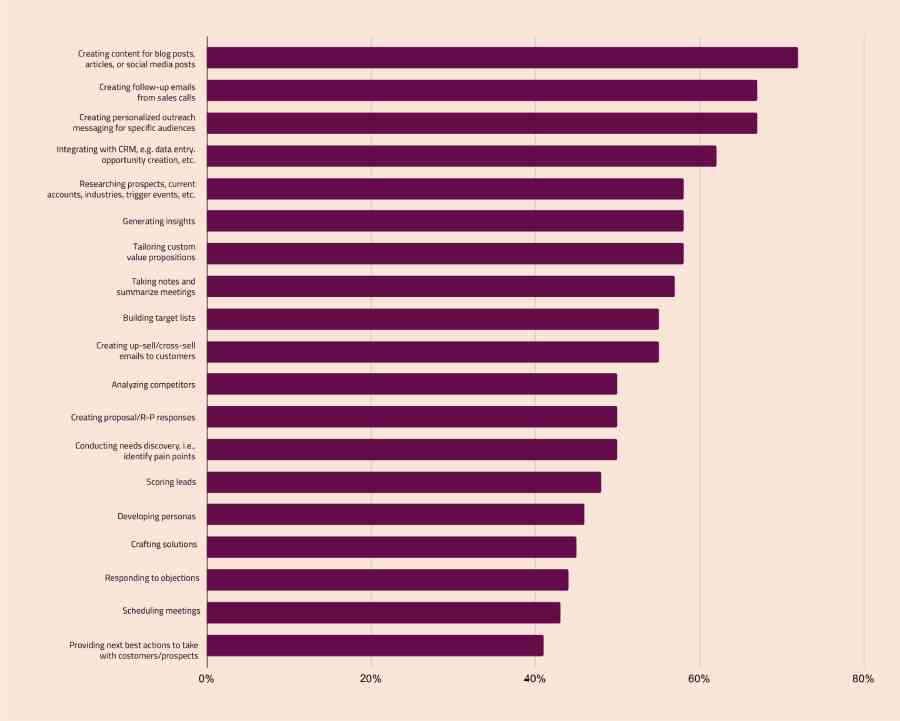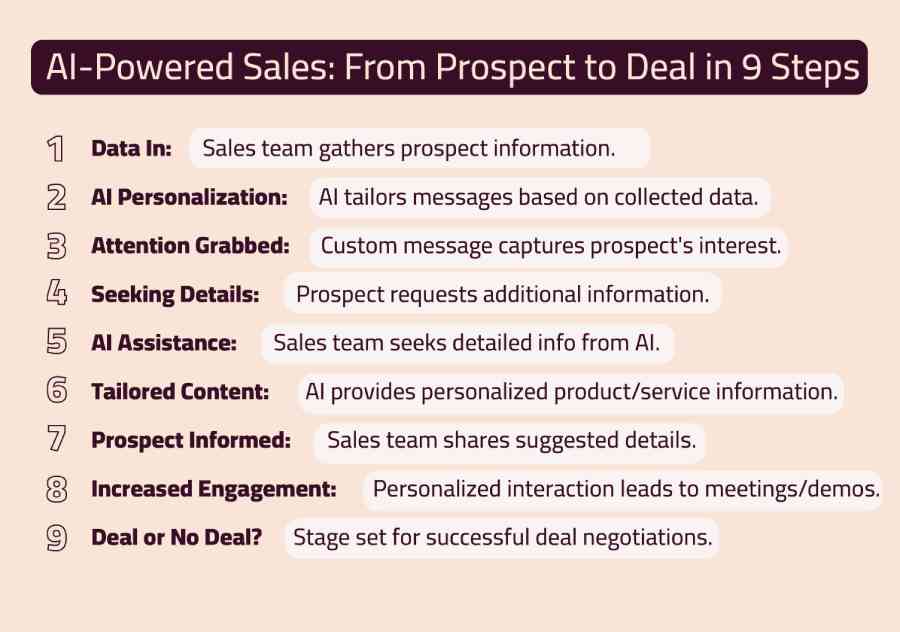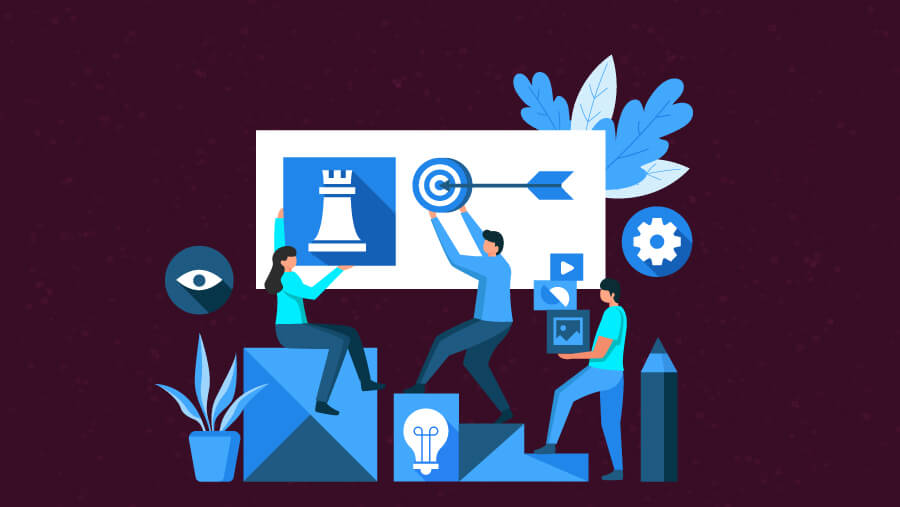
Outbound Marketing 2.0: How Emerging Tech Fuels Growth in 2024
“AI is probably going to be the single biggest disruptor and enabler of marketing in total. It’s a dream come true, from a marketer’s perspective.”
Raja Rajammanar, Chief Marketing & Communications Officer of Mastercard
This statement rings true, especially in outbound marketing and sales. Emerging technologies like AI, Big Data, and Social Selling are transforming how businesses reach and engage potential customers.
The proof lies in the statistics: 54% of organizations report cost savings and improved efficiencies by leveraging AI in their outbound marketing efforts.
We stand at the precipice of a technological revolution. The question no longer becomes whether to embrace these advancements but how.
Let’s explore how to use emerging technologies to craft impactful, results-oriented outbound marketing strategies in 2024.
Emerging Technologies Transforming Outbound Marketing
A new wave of innovative technologies transforms how you reach and engage potential customers. These advancements empower you to personalize outreach, improve efficiency, and drive significant sales performance gains.
1. Personalization Through AI
A high percentage of sales teams strongly agree they get value from AI in ways including:

You can use AI to redefine your lead generation and scoring approach. It opens the door to a new personalized and efficient outbound marketing era. 63% of respondents agree that AI enables tailored interactions with prospects. This can lead to higher satisfaction and loyalty, as prospects and customers feel understood and valued.
Let’s check out some approaches:
- Lead Generation and Scoring: You must rely on more than intuition or basic demographics to identify your potential customers. AI algorithms can analyze vast amounts of data, including:
- Website behavior
- Social media engagement
- Past interactions
– to pinpoint high-value leads with a greater likelihood of converting.
It allows your sales team to prioritize their efforts and focus on the most promising opportunities, significantly improving efficiency.
- Lead Qualification: Chatbots equipped with AI can act as virtual assistants, thereby:
- Engaging website visitors
- Answering basic questions
- Qualifying leads in real-time
It frees up valuable time for your sales representatives to concentrate on nurturing high-potential leads and closing deals.
- Predictive Analytics: AI can analyze historical sales data, customer behavior patterns, and market trends – to predict buying behavior. It enables you to tailor your messaging and outreach strategies to individual needs and preferences.
Tool Recommendations to Integrate AI into Outbound Marketing:
- HubSpot: Offers AI-powered lead scoring and marketing automation to help you prioritize and engage potential customers based on their online behavior and interaction history.
- Salesforce Einstein: Enhances customer relationship management (CRM) with predictive analytics, offering insights into customer behavior and sales trends.
- ChatGPT (OpenAI): Automates and personalizes communication with prospects and customers. ChatGPT's advanced natural language processing capabilities allow for the creation of:
- Personalized email content
- Chatbot conversations
- Sales scripts
– making it a versatile tool for enhancing outbound marketing efforts.
Its ability to generate human-like text based on prior interactions can lead to more engaging and effective communication strategies.
For instance, check out this interaction between a sales team and prospects:

2. Streamlined Outreach with Email Automation
Email marketing remains a powerful tool in the outbound marketer's arsenal. Most marketers report an average email open rate of 46-50%.
However, manually crafting and sending personalized emails can be time-consuming and limit reach. Marketing automation tools leverage customer data to trigger targeted email sequences based on specific behaviors and interests.
For instance, a potential customer downloading a white paper on a particular topic can automatically receive a follow-up email with additional relevant content or a special offer. This personalized approach fosters engagement, nurtures sales funnel leads, and improves conversion rates.
Tool Recommendations to Integrate Email Automation into Outbound Marketing:
- Mailchimp: Offers automation features, letting you send personalized emails based on customer behavior and preferences.
- ActiveCampaign: Provides advanced email marketing automation, integrating AI to help you create targeted email campaigns that adapt to user actions.
- Clay.com: Specializes in data-driven automation and personalization for email outreach. Also, it can write hyper-personalized emails with AI.
3. Segmentation Through Big Data
Leveraging vast amounts of customer data (Big Data) is a game-changer in outbound marketing. You can segment your audience into groups based on demographics, interests, and past interactions.
This granular segmentation allows for highly targeted outreach campaigns with personalized messaging that resonates with each audience segment.
For example, let’s assume your company offers marketing software. You could send targeted email campaigns to marketing managers highlighting features that address their specific challenges. This is more effective than sending a generic message to a broad audience.
Tool Recommendations to Integrate Big Data into Outbound Marketing:
- Tableau: Helps you analyze and segment customer data to craft personalized marketing strategies.
- Google Analytics: Offers comprehensive insights into website traffic and user behavior, allowing for effective segmentation and targeted marketing.
4. Targeting Via Programmatic Advertising
By leveraging AI and automation, programmatic advertising allows you to purchase ad space across multiple platforms with laser-focused targeting capabilities. It ensures your marketing message reaches the right audience at the right time, maximizing campaign effectiveness.
Tool Recommendations to Integrate Programmatic Advertising into Outbound Marketing:
- Adobe Advertising Cloud: Provides a comprehensive platform for automated, cross-channel media buying, using AI to optimize ad placements and targeting.
- MediaMath: Offers solutions that automate buying and optimizing digital advertising campaigns.
5. Optimization With Marketing Attribution Tools
These tools track and analyze the performance of various marketing channels, providing valuable insights into which strategies drive the most leads and conversions. This data-driven approach enables you to optimize your outbound marketing efforts for maximum return on investment (ROI).
Tool Recommendations to Integrate Attribution Tools into Outbound Marketing:
- Google Ads Attribution: Gives detailed reports on how different marketing channels contribute to conversions. It helps you optimize your outbound efforts.
- HubSpot Marketing Hub: Offers detailed analytics and attribution tools that track the performance of marketing campaigns across various channels.
6. Insights Through Connected Devices and IoT

The Internet of Things (IoT) connects everyday objects to the Internet, enabling data exchange and automation. IoT devices can provide valuable insights into customer behavior and preferences in outbound marketing. Examples include:
- Smart Home Devices: Collect usage patterns and preferences data, enabling targeted marketing campaigns.
- Wearable Technology: Track fitness or health data, providing opportunities for personalized marketing messages or offers.
- Connected Vehicles: Gather driving habits or location data, allowing for location-based marketing initiatives.
Tool Recommendations to Integrate IoT into Outbound Marketing:
- AWS IoT Core: Connects and manages IoT devices at scale, integrating data into marketing strategies for personalized customer engagement.
- Microsoft Azure IoT Suite: Provides real-time solutions for collecting, analyzing, and acting on IoT data. It supports contextually relevant marketing campaigns.
7. Clarity Via Blockchain Technology
Blockchain can significantly impact outbound marketing, especially by enhancing transparency and trust. Blockchain lets you provide verifiable and immutable data records, ensuring campaign authenticity and improving customer trust.
This technology can also facilitate secure and transparent transactions, enabling direct and reliable customer engagement.
You can use blockchain to verify the authenticity of advertising traffic, reducing costs associated with fake clicks and impressions. Blockchain-based systems offer customers more control over their data. It boosts privacy and compliance with regulations like GDPR.
Tool Recommendations to Blockchain into Outbound Marketing:
- IBM Blockchain: Offers solutions for creating transparent and secure digital records. It boosts customer trust and enables verifiable outbound marketing campaigns.
- Hyperledger: Develops secure and transparent solutions for digital advertising and customer data management.
8. Immersive Client Experiences Through AR and VR
Augmented Reality (AR) and Virtual Reality (VR) can revolutionize outbound marketing by creating immersive and interactive customer experiences. These technologies allow you to showcase products and services highly engagingly. They improve customer understanding and enhance the purchasing journey.
You can use AR/VR to provide potential customers with a virtual hands-on product experience regardless of their physical location. Additionally, you can create VR marketing campaigns that immerse users in your brand and strengthen their emotional connection.
Tool Recommendations to Integrate AR/VR into Outbound Marketing:
- Unity: Creates and operates interactive, real-time 3D content, including AR and VR experiences. It can be used for engaging product demos and marketing campaigns.
- Adobe Aero: Enables designers and marketers to create immersive AR experiences, enhancing product visualizations and interactive marketing campaigns.
9. Increased Traffic Via Voice Search Optimization
With the rise of smart speakers and voice assistants, optimizing outbound marketing for voice search is becoming increasingly important. Voice search optimization can help you capture organic traffic from spoken queries, which often differ from typed searches in intent and phrasing.
You can develop content specifically designed for voice search, focusing on conversational keywords and phrases. You can also optimize for local search queries, as voice searches are often used for local information. This enhances visibility in local outbound marketing efforts.
Tool Recommendations to Integrate Voice Search Optimization into Outbound Marketing:
- SEMrush: Offers tools for optimizing content for voice search. It includes keyword research and site audit features focusing on conversational phrases and local search optimization.
- Moz Local: Improves local SEO, which is crucial for voice search, by managing regional business listings and optimizing search presence.
10. Rapid Connection-Building with 5G
The rollout of 5G technology can accelerate outbound marketing strategies by enabling faster and more reliable internet connections. It can improve the delivery of media-rich marketing content. It also supports advanced technologies like AR and VR, providing seamless customer experiences.
You can utilize 5G to deliver high-quality, instant-loading video content on mobile devices. This improves engagement in outbound marketing campaigns. Plus, you can leverage the speed of 5G to process customer data in real-time, enabling more timely and relevant marketing interactions.
Tool Recommendations to Integrate 5G into Outbound Marketing:
- Qualcomm: Provides 5G tech solutions to enhance mobile marketing campaigns with faster and more reliable connections. It supports high-quality video and real-time data processing.
- Cisco: Offers 5G network infrastructure for improved connectivity, facilitating real-time analytics and enhanced customer experiences in outbound marketing.
How to Implement Emerging Tech in Your Outbound Marketing Endeavors?
You can streamline the implementation process and enhance your marketing efforts with the right approach. Here are practical tips for effective deployment of emerging technologies:
1. Define Clear Objectives
- Goal Alignment: Clearly define what you aim to achieve with new technologies, such as:
Increasing lead quality
Enhancing customer engagement
Improving conversion rates
- Technology Fit: Ensure the technology aligns with your marketing goals. For AI-driven personalization, determine how it will improve customer targeting and content relevance.
2. Assess Your Current Infrastructure
- Compatibility Check: Evaluate your existing marketing tools and systems to ensure they integrate with the new technology. Consider any necessary upgrades or changes.
- Data Readiness: Assess the quality and accessibility of your data, as technologies like AI and Big Data rely heavily on data inputs for effective outcomes.
3. Prioritize User Training and Support
- Staff Training: Invest in training so your marketing team can use the new technology effectively. Understanding its functionalities and benefits will facilitate smoother integration and utilization.
- Ongoing Support: Choose technology providers that offer robust customer support, including:
- Training resources
- Help desks
- Community forums for troubleshooting
4. Start with a Pilot Project
- Scope Definition: Launch a pilot project with a specific segment of your marketing campaign to test the technology’s impact and feasibility.
- Measurement and Tracking: Carefully monitor the pilot’s performance, gathering data on its effectiveness, user adoption, and operational challenges.
5. Evaluate and Scale Gradually
- Performance Analysis: After the pilot, analyze the results against your objectives. Identify areas of success and improvement to inform broader implementation.
- Scalable Rollout: Plan a phased rollout based on the pilot’s success. Gradually expand the technology’s use across other marketing areas to manage the change effectively.
6. Leverage Data for Continuous Improvement
- Feedback Loop: Use the data and insights from your technology implementation to refine and improve your marketing strategies continuously.
- Iterative Optimization: Regularly review the technology’s performance and make necessary adjustments. This ensures it remains aligned with your marketing goals and market changes.
7. Foster a Culture of Innovation
- Encourage Experimentation: Promote a culture where team members can experiment with new technologies and strategies. It fosters innovation and adaptation.
- Stay Updated: Keep abreast of emerging trends and technologies in outbound marketing to continuously enhance your strategies and stay competitive.
Final Word
Outbound Marketing 2.0 in 2024 is a strategic evolution that integrates emerging technologies. These innovations offer unprecedented opportunities to personalize outreach, enhance efficiency, and drive significant growth. Businesses that leverage these technologies will stay ahead of the curve and set new benchmarks.
Integrating these technologies into your outbound marketing strategy may seem complex, but it's entirely achievable with the right tools and approaches. If you're ready to fuel your business growth with the power of emerging tech, contact Revnew today. Start your journey now!



![11 Strategies to Find B2B Decision Makers [Bonus Added]](https://revnew.com/hs-fs/hubfs/Revnew/Images/other%20img/How-to-Find-b2b-decision-makers-in.jpg?width=352&name=How-to-Find-b2b-decision-makers-in.jpg)
